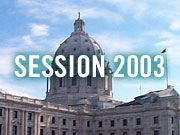Audio
Photos
More from MPR
Your Voice
| ||||||||||||||||||||||||||||||||||||||||||||||||||||
Tolls for thee, Minnesota?
April 24, 2003
 |
| Rep. Mark Kennedy, R-Minn., and Gov. Tim Pawlenty teamed up on a proposal they say will alleviate congestion on metro highways. (MPR Photo/Michael Khoo) |
St. Paul, Minn. — Gov. Pawlenty says he envisions new highway lanes to be built by private companies and financed by drivers willing to pay for a speedier commute. Once the construction costs are retired, the tolls would disappear and the lanes would be open for general use. Pawlenty says there's an important distinction between this concept and traditional toll roads.
"This is not a toll road in the sense that in toll roads everybody has to pay," he said. "Under this concept, it's voluntary. That's number one. Number two, in terms of the advantages of the people who choose to use the road and pay, it includes that it then takes traffic out of the traditional lanes and takes burden off the traditional lanes."
Pawlenty says the proposal would accelerate the development of construction projects across the state. He says Minnesota may already have the authority to begin developing the so-called "FAST" lanes on state highways. But doing so on federal interstates would require congressional action.
Sixth District GOP Congressman Mark Kennedy says he's introduced legislation in Washington to lift federal restrictions on toll lanes. Kennedy says the new lanes would offer additional options for commuters frustrated with snarled traffic.
"When you're stuck in traffic, when you're deadstopped in the southwest corner of 494 at 10:30 in the morning, should you have the option of moving into a lane where you pay a little fee and you get to where you're going on time? This is something that I think people ought to have that choice," Kennedy said.
Fees would be collected electronically by sensors built into the roadway. Transportation officials could also adjust the tolls to regulate traffic flow, increasing them, for example, during rush hour.
The plan has the support of state lawmakers from both sides of the aisle. Sen. Dean Johnson, DFL-Willmar, who chairs the Senate Transportation Budget Division, says tollways won't replace traditional road funding, which comes largely from the state's gas tax. But he says the state's transportation needs demand new solutions.
"People in west central Minnesota and southern Minnesota drive into the metropolitan area for a job. And we need to figure out ways to transport people from their homes to their places of work in a more speedily fashion, efficient way," Johnson said.
State lawmakers and Minnesota Department of Transportation officials are also considering a separate toll-based idea: opening high occupancy vehicle lanes on Interstates 394 and 35W to solo drivers willing to pay a fee.
Several states, including California and Texas, have already experimented with so-called HOT -- or High Occupancy Toll -- lanes. Al Steger of the Federal Highway Administration's Minnesota division says transportation experts from across the country are carefully watching those projects.
"There's no reason to believe that we wouldn't work with MnDOT to make it successful here as well. There are a lot of details to be worked out, obviously. And I think over time we could do that. And we've agreed that we would work with MnDOT to make it successful," Steger said.
Steger says he's unable to comment on the other parts of the plan, including Kennedy's pending legislation to authorize FAST lanes. Pawlenty says, with the appropriate approval, Minnesotans could see their first pay-for-use demonstration project in as little as 18 months to two years.
|
News Headlines
|
Related Subjects
|

